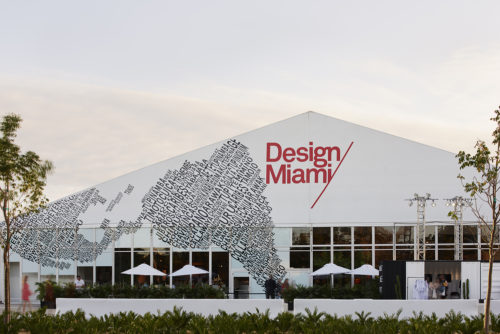Dec 26, 2019 Design Miami 2019

At this year’s Design Miami fair, exhibitors dipped their toes into the curatorial theme of water and consequently made a splash about sustainability. Miami Beach is a city in peril. Commonly placed near the top of lists that describe urban areas vulnerable to rising sea levels, the low-lying coastal region’s regular flooding brings the existential threat of climate change to residents’ doorsteps.
But unless the floods occur during early December, the thousands of people that descend upon the sand for the city’s Art Basel event and annual art week probably don’t give this a second thought. So it was a pleasant surprise that the Design Miami fair – one of many taking place during the week – chose “Water” as its curatorial theme for the 2019 edition.
Following “Earth” at the sister event in Basel earlier this year and anticipating further elemental threads at upcoming Design Miami editions, curator Aric Chen’s call for aqueous subject matter manifested itself in several ways.
The Design Forum at Design Miami hosted several water-themed talks during the event.
The most evident was through the fair’s Design Forum talks series, which predominantly involved panel discussions that related to water. Presented by the Savannah College of Art and Design (SCAD), the program included a talk about the University of Miami’s various coastal resilience projects, crystal brand Swarovski’s water-related initiatives.
Lonely Whale and Point Break Foundation teamed up to highlight the build-up of single-use plastic along global coastlines, and A/D/O presented an overview of its year-long research program Water Futures that focused on how design can help to tackle the global water crisis – coinciding with the program’s catalog launch.
At the fair’s entrance, the Coral City Camera showed a livestream of a fragile underwater ecosystem.
Having such a tangible overarching theme also helped to tie together some of the fair’s often disparate sets of programs and commissions.
Once inside the venue – a temporary tent located beside the Miami Beach Convention Center – visitors were met with a large projected livestream from an underwater camera in nearby Biscayne Bay. The ongoing Coral City Camera project aims to raise awareness of the fragility of reefs and their ecosystems, and gave Design Miami attendees a taste of the exhibits to follow.
Exhibitors like Swarovski used their booths to highlight water-related initiatives.
These included literal interpretations of the water theme, like Studio Swine’s installation of interconnected inflatable bubbles commissioned by Instagram, and Swarovski’s droplet-shaped crystals presented to raise awareness of the company’s Waterschool community investment program.
Other nods to water were more subtle but no less effective. At the Carpenters Workshop Gallery booth, Virgil Abloh’s furniture appeared to be sinking into wet ground and Japanese studio Takt Project’s Glow Grow: Pottery – part of the fair’s Curio program – featured resin vessels that grew like ice formations while hardened by LED lights inside (main image).
Subtle nods to water could also be seen in pieces like Virgil Abloh’s “sinking” furniture.
Amorphous design was a standout trend this year. From numerous gloopy seats to an entire Flintstones-equse living room vignette presented by New York gallery R&Company, many objects had fluid shapes, curvaceous corners and globular nodes. Pieces from Pierre Marie Giraud, Jason Jacques Gallery, Galerie Scene Ouverte, and Friedman Benda all exhibited these qualities – whether intentionally playing up to the water theme or not.
A trend for amorphous design was exemplified at R&Company’s Flintstones-esque booth.
The notions of water and sustainability were also apparent across many of the art week’s other affiliate events and independent exhibits. Argentinian artist Leandro Erlich sculpted a semi-submerged traffic jam from sand – one of the week’s most Instagrammed attractions – to emulate driving along a flooded highway, while Berlin art duo Elmgreen and Dragset installed a folded swimming pool outside the convention center.
The art and design worlds have been drawing focus to the climate crisis ever since it first became apparent, but events like Art Basel that draw so much attention from the media and the meme-makers are the perfect platform for highlighting such a critical global issue. It’s just a shame that the week’s most-talked-about exhibit ended up being a $120,000 banana taped to a wall.


